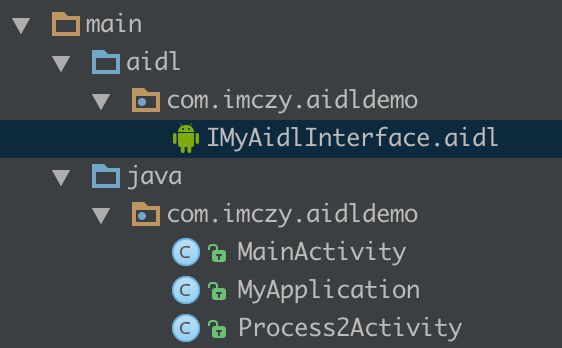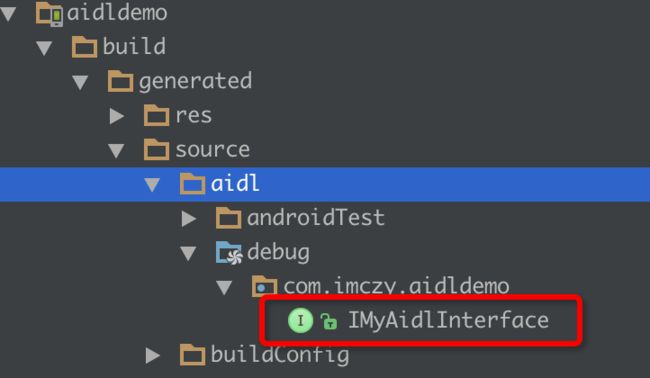AIDL 使用学习
最近遇到了一些多进程的问题,现在来总结学习下,
默认情况下, app 只占用一个进程.
但是偶尔会遇到一些特殊的需求,需要吧一些任务放到另外一个进程去执行, 这样就需要用到多进程了
1. 声明多进程
声明多进程很简单, 只需要在mainfest文件中, 指定相应activity service等 是在哪个进程 如下所示:
<activity
android:name=".Process2Activity"
android:process=":process2"/>
如果没有写 android:process 则默认是在主进程
上面的那个 Process2Activity 是在 process2进程中得.
那么 当在
启动 Process2Activity 时
如果该进程不存在则会启动一个新的进程, 同时还会启动这个进程对应的Application
(可以初略的理解为 启动另一个app )
如下log
当然Service也是如上声明,就不在赘述
注意
1. 当启动其他进程的组件时, 会创建一个新进程(如果该进程不存在的话),那么会增大app所暂用的内存, 应当酌情考虑是否使用多进程
2. 主进程与其他进程之间的 对象都是相互独立的, 如果在主进程有ClassA的单例, 那么在进程Process2 中相应的ClassA的单例与主进程不是同一个,因为他们使用的不是同一块内存
3.当进程起来后,就不会自动的死掉, 需要适当考虑,是否收到吧另外一个进程杀掉,防止占用内存
2. 多进程间通信AIDL
上面有提到说, 主进程与Process2经常使用的不是同一块内存, 对象是相互独立的,
那么问题来了,
如果主进程 向 调用Process2进程中某个功能 方法时, 就不能简单的通过执行对象的方法来实现了.
因为在正常情况下 主进程是哪不到 Process2 的对象的.
但是又不得不这样做时, 那么就需要用到AIDL 了跨进程通信了
AIDL (Android Interface Definition Language,即Android接口定义语言)
先来学习如何使用AIDL吧 文档( http://developer.android.com/guide/components/aidl.html )
2.1 创建AIDL file
2.1 定义AIDL 接口
这里 测试 在Process2 进程中通过AIDL 获取主进程的pid
interface IMyAidlInterface {
/**
* Demonstrates some basic types that you can use as parameters
* and return values in AIDL.
*/
void basicTypes(int anInt, long aLong, boolean aBoolean, float aFloat,
double aDouble, String aString);
int getPid();
}
使用AndroidStudi 它不会自动生成 相应的IMyAidlInterface.java文件,
它会在编译的时候生成, 如下图:
可以把它拷贝出来放到 AIDL文件相同目录下去, 也可以不去管它
参考链接( http://chenqichao.me/2014/05/13/003-Android-Studio-AIDL/ )
2.2 实现接口, 以及服务端
需要定义一个service如下
public class MainService extends Service {
public static final String TAG = "MainService";
@Override
public void onCreate() {
super.onCreate();
LogUtil.d(TAG, "onCreate");
}
@Nullable
@Override
public IBinder onBind(Intent intent) {
LogUtil.d(TAG, "onBind");
return mBinder;
}
private IMyAidlInterface.Stub mBinder = new IMyAidlInterface.Stub() {
@Override
public void basicTypes(int anInt, long aLong, boolean aBoolean, float aFloat, double aDouble, String aString) throws RemoteException {
}
@Override
public int getPid() throws RemoteException {
// 返回当前 service 的pic
LogUtil.d(TAG, "getPid");
return android.os.Process.myPid();
}
};
}
然后在mainfest中申明该service
至此 服务端即主进程的工作以及完毕了.
2.3 Process2 连接主进程 即 客户端连接服务端
在 Process2Activity 中定义一个ServiceConnection 如下
IMyAidlInterface mIMyAidlInterface;
private ServiceConnection mConnection = new ServiceConnection() {
// Called when the connection with the service is established
public void onServiceConnected(ComponentName className, IBinder service) {
// Following the example above for an AIDL interface,
// this gets an instance of the IRemoteInterface, which we can use to call on the service
LogUtil.d(TAG, "onServiceConnected");
mIMyAidlInterface = IMyAidlInterface.Stub.asInterface(service);
try {
mMsgTxt.setText("main pic = " + mIMyAidlInterface.getPid());
} catch (Exception e) {
e.printStackTrace();
}
}
// Called when the connection with the service disconnects unexpectedly
public void onServiceDisconnected(ComponentName className) {
LogUtil.e(TAG, "Service has unexpectedly disconnected");
mIMyAidlInterface = null;
}
};
然后在使用该connection连接主进程中创建的 service即可
Intent intent = new Intent(Process2Activity.this, MainService.class); bindService(intent, mConnection, Context.BIND_AUTO_CREATE);
连接成功机会执行
public void onServiceConnected(ComponentName className, IBinder service) 方法
随后执行 mIMyAidlInterface = IMyAidlInterface.Stub.asInterface(service);
即可得相应的我们定义的AIDL接口的代理对象, 然后可以执行相应的方法
mIMyAidlInterface.getPid()
至此 就完成了 多进程间AIDL 的通信
注意
需要在适当的适合
unbindService

